Zhengmian Hu
Voice Evaluation of Reasoning Ability: Diagnosing the Modality-Induced Performance Gap
Sep 30, 2025Abstract:We present Voice Evaluation of Reasoning Ability (VERA), a benchmark for evaluating reasoning ability in voice-interactive systems under real-time conversational constraints. VERA comprises 2,931 voice-native episodes derived from established text benchmarks and organized into five tracks (Math, Web, Science, Long-Context, Factual). Each item is adapted for speech interaction while preserving reasoning difficulty. VERA enables direct text-voice comparison within model families and supports analysis of how architectural choices affect reliability. We assess 12 contemporary voice systems alongside strong text baselines and observe large, consistent modality gaps: on competition mathematics a leading text model attains 74.8% accuracy while its voice counterpart reaches 6.1%; macro-averaged across tracks the best text models achieve 54.0% versus 11.3% for voice. Latency-accuracy analyses reveal a low-latency plateau, where fast voice systems cluster around ~10% accuracy, while approaching text performance requires sacrificing real-time interaction. Diagnostic experiments indicate that common mitigations are insufficient. Increasing "thinking time" yields negligible gains; a decoupled cascade that separates reasoning from narration improves accuracy but still falls well short of text and introduces characteristic grounding/consistency errors. Failure analyses further show distinct error signatures across native streaming, end-to-end, and cascade designs. VERA provides a reproducible testbed and targeted diagnostics for architectures that decouple thinking from speaking, offering a principled way to measure progress toward real-time voice assistants that are both fluent and reliably reasoned.
A Personalized Conversational Benchmark: Towards Simulating Personalized Conversations
May 20, 2025Abstract:We present PersonaConvBench, a large-scale benchmark for evaluating personalized reasoning and generation in multi-turn conversations with large language models (LLMs). Unlike existing work that focuses on either personalization or conversational structure in isolation, PersonaConvBench integrates both, offering three core tasks: sentence classification, impact regression, and user-centric text generation across ten diverse Reddit-based domains. This design enables systematic analysis of how personalized conversational context shapes LLM outputs in realistic multi-user scenarios. We benchmark several commercial and open-source LLMs under a unified prompting setup and observe that incorporating personalized history yields substantial performance improvements, including a 198 percent relative gain over the best non-conversational baseline in sentiment classification. By releasing PersonaConvBench with evaluations and code, we aim to support research on LLMs that adapt to individual styles, track long-term context, and produce contextually rich, engaging responses.
Exploring Rewriting Approaches for Different Conversational Tasks
Feb 26, 2025



Abstract:Conversational assistants often require a question rewriting algorithm that leverages a subset of past interactions to provide a more meaningful (accurate) answer to the user's question or request. However, the exact rewriting approach may often depend on the use case and application-specific tasks supported by the conversational assistant, among other constraints. In this paper, we systematically investigate two different approaches, denoted as rewriting and fusion, on two fundamentally different generation tasks, including a text-to-text generation task and a multimodal generative task that takes as input text and generates a visualization or data table that answers the user's question. Our results indicate that the specific rewriting or fusion approach highly depends on the underlying use case and generative task. In particular, we find that for a conversational question-answering assistant, the query rewriting approach performs best, whereas for a data analysis assistant that generates visualizations and data tables based on the user's conversation with the assistant, the fusion approach works best. Notably, we explore two datasets for the data analysis assistant use case, for short and long conversations, and we find that query fusion always performs better, whereas for the conversational text-based question-answering, the query rewrite approach performs best.
Towards Optimal Multi-draft Speculative Decoding
Feb 26, 2025Abstract:Large Language Models (LLMs) have become an indispensable part of natural language processing tasks. However, autoregressive sampling has become an efficiency bottleneck. Multi-Draft Speculative Decoding (MDSD) is a recent approach where, when generating each token, a small draft model generates multiple drafts, and the target LLM verifies them in parallel, ensuring that the final output conforms to the target model distribution. The two main design choices in MDSD are the draft sampling method and the verification algorithm. For a fixed draft sampling method, the optimal acceptance rate is a solution to an optimal transport problem, but the complexity of this problem makes it difficult to solve for the optimal acceptance rate and measure the gap between existing verification algorithms and the theoretical upper bound. This paper discusses the dual of the optimal transport problem, providing a way to efficiently compute the optimal acceptance rate. For the first time, we measure the theoretical upper bound of MDSD efficiency for vocabulary sizes in the thousands and quantify the gap between existing verification algorithms and this bound. We also compare different draft sampling methods based on their optimal acceptance rates. Our results show that the draft sampling method strongly influences the optimal acceptance rate, with sampling without replacement outperforming sampling with replacement. Additionally, existing verification algorithms do not reach the theoretical upper bound for both without replacement and with replacement sampling. Our findings suggest that carefully designed draft sampling methods can potentially improve the optimal acceptance rate and enable the development of verification algorithms that closely match the theoretical upper bound.
From Selection to Generation: A Survey of LLM-based Active Learning
Feb 17, 2025Abstract:Active Learning (AL) has been a powerful paradigm for improving model efficiency and performance by selecting the most informative data points for labeling and training. In recent active learning frameworks, Large Language Models (LLMs) have been employed not only for selection but also for generating entirely new data instances and providing more cost-effective annotations. Motivated by the increasing importance of high-quality data and efficient model training in the era of LLMs, we present a comprehensive survey on LLM-based Active Learning. We introduce an intuitive taxonomy that categorizes these techniques and discuss the transformative roles LLMs can play in the active learning loop. We further examine the impact of AL on LLM learning paradigms and its applications across various domains. Finally, we identify open challenges and propose future research directions. This survey aims to serve as an up-to-date resource for researchers and practitioners seeking to gain an intuitive understanding of LLM-based AL techniques and deploy them to new applications.
GUI Agents: A Survey
Dec 18, 2024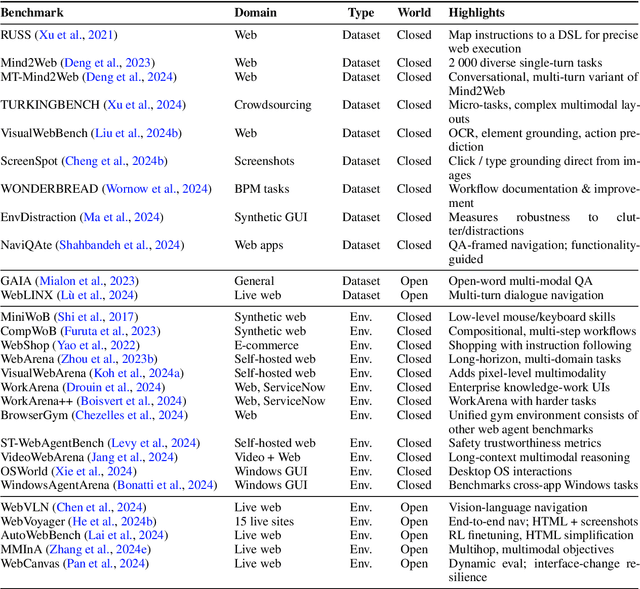
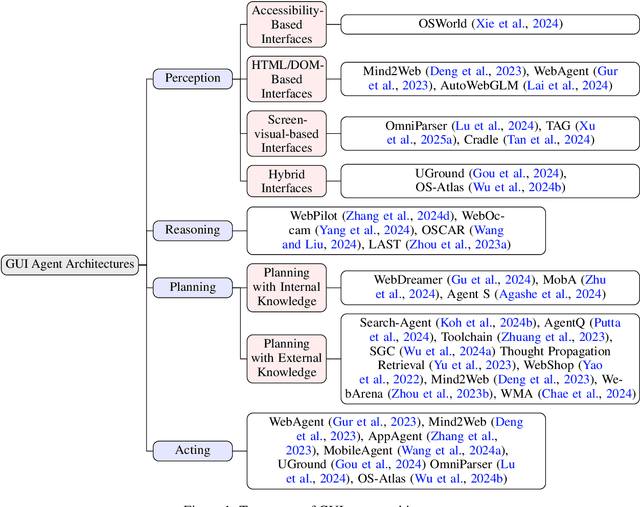

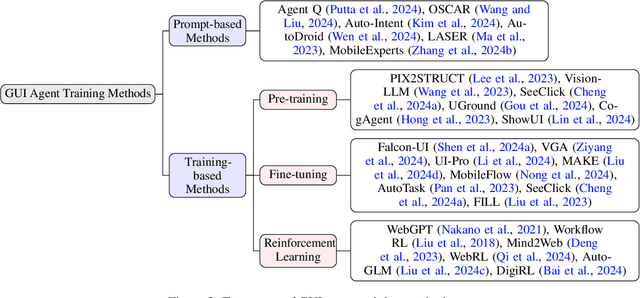
Abstract:Graphical User Interface (GUI) agents, powered by Large Foundation Models, have emerged as a transformative approach to automating human-computer interaction. These agents autonomously interact with digital systems or software applications via GUIs, emulating human actions such as clicking, typing, and navigating visual elements across diverse platforms. Motivated by the growing interest and fundamental importance of GUI agents, we provide a comprehensive survey that categorizes their benchmarks, evaluation metrics, architectures, and training methods. We propose a unified framework that delineates their perception, reasoning, planning, and acting capabilities. Furthermore, we identify important open challenges and discuss key future directions. Finally, this work serves as a basis for practitioners and researchers to gain an intuitive understanding of current progress, techniques, benchmarks, and critical open problems that remain to be addressed.
Personalized Multimodal Large Language Models: A Survey
Dec 03, 2024Abstract:Multimodal Large Language Models (MLLMs) have become increasingly important due to their state-of-the-art performance and ability to integrate multiple data modalities, such as text, images, and audio, to perform complex tasks with high accuracy. This paper presents a comprehensive survey on personalized multimodal large language models, focusing on their architecture, training methods, and applications. We propose an intuitive taxonomy for categorizing the techniques used to personalize MLLMs to individual users, and discuss the techniques accordingly. Furthermore, we discuss how such techniques can be combined or adapted when appropriate, highlighting their advantages and underlying rationale. We also provide a succinct summary of personalization tasks investigated in existing research, along with the evaluation metrics commonly used. Additionally, we summarize the datasets that are useful for benchmarking personalized MLLMs. Finally, we outline critical open challenges. This survey aims to serve as a valuable resource for researchers and practitioners seeking to understand and advance the development of personalized multimodal large language models.
Fast and scalable Wasserstein-1 neural optimal transport solver for single-cell perturbation prediction
Nov 01, 2024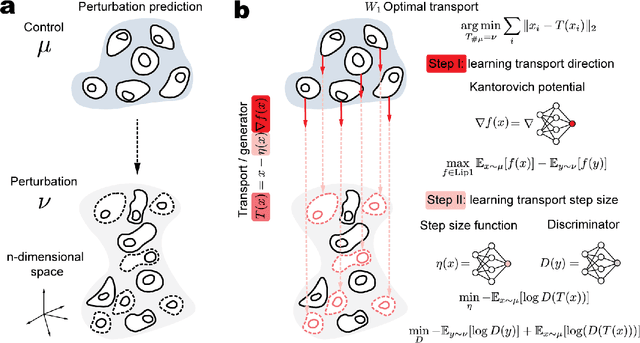

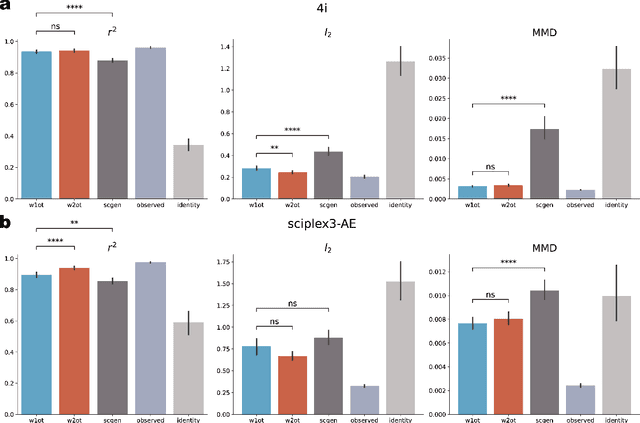

Abstract:Predicting single-cell perturbation responses requires mapping between two unpaired single-cell data distributions. Optimal transport (OT) theory provides a principled framework for constructing such mappings by minimizing transport cost. Recently, Wasserstein-2 ($W_2$) neural optimal transport solvers (\textit{e.g.}, CellOT) have been employed for this prediction task. However, $W_2$ OT relies on the general Kantorovich dual formulation, which involves optimizing over two conjugate functions, leading to a complex min-max optimization problem that converges slowly. To address these challenges, we propose a novel solver based on the Wasserstein-1 ($W_1$) dual formulation. Unlike $W_2$, the $W_1$ dual simplifies the optimization to a maximization problem over a single 1-Lipschitz function, thus eliminating the need for time-consuming min-max optimization. While solving the $W_1$ dual only reveals the transport direction and does not directly provide a unique optimal transport map, we incorporate an additional step using adversarial training to determine an appropriate transport step size, effectively recovering the transport map. Our experiments demonstrate that the proposed $W_1$ neural optimal transport solver can mimic the $W_2$ OT solvers in finding a unique and ``monotonic" map on 2D datasets. Moreover, the $W_1$ OT solver achieves performance on par with or surpasses $W_2$ OT solvers on real single-cell perturbation datasets. Furthermore, we show that $W_1$ OT solver achieves $25 \sim 45\times$ speedup, scales better on high dimensional transportation task, and can be directly applied on single-cell RNA-seq dataset with highly variable genes. Our implementation and experiments are open-sourced at \url{https://github.com/poseidonchan/w1ot}.
A Bayesian Approach to Harnessing the Power of LLMs in Authorship Attribution
Oct 29, 2024Abstract:Authorship attribution aims to identify the origin or author of a document. Traditional approaches have heavily relied on manual features and fail to capture long-range correlations, limiting their effectiveness. Recent advancements leverage text embeddings from pre-trained language models, which require significant fine-tuning on labeled data, posing challenges in data dependency and limited interpretability. Large Language Models (LLMs), with their deep reasoning capabilities and ability to maintain long-range textual associations, offer a promising alternative. This study explores the potential of pre-trained LLMs in one-shot authorship attribution, specifically utilizing Bayesian approaches and probability outputs of LLMs. Our methodology calculates the probability that a text entails previous writings of an author, reflecting a more nuanced understanding of authorship. By utilizing only pre-trained models such as Llama-3-70B, our results on the IMDb and blog datasets show an impressive 85\% accuracy in one-shot authorship classification across ten authors. Our findings set new baselines for one-shot authorship analysis using LLMs and expand the application scope of these models in forensic linguistics. This work also includes extensive ablation studies to validate our approach.
Inevitable Trade-off between Watermark Strength and Speculative Sampling Efficiency for Language Models
Oct 27, 2024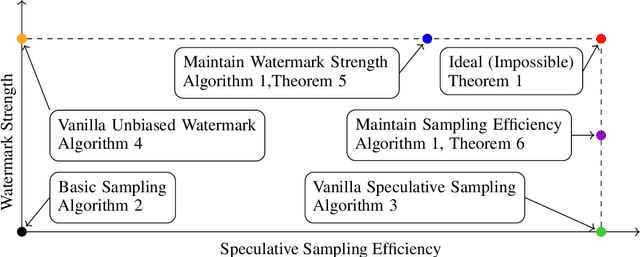
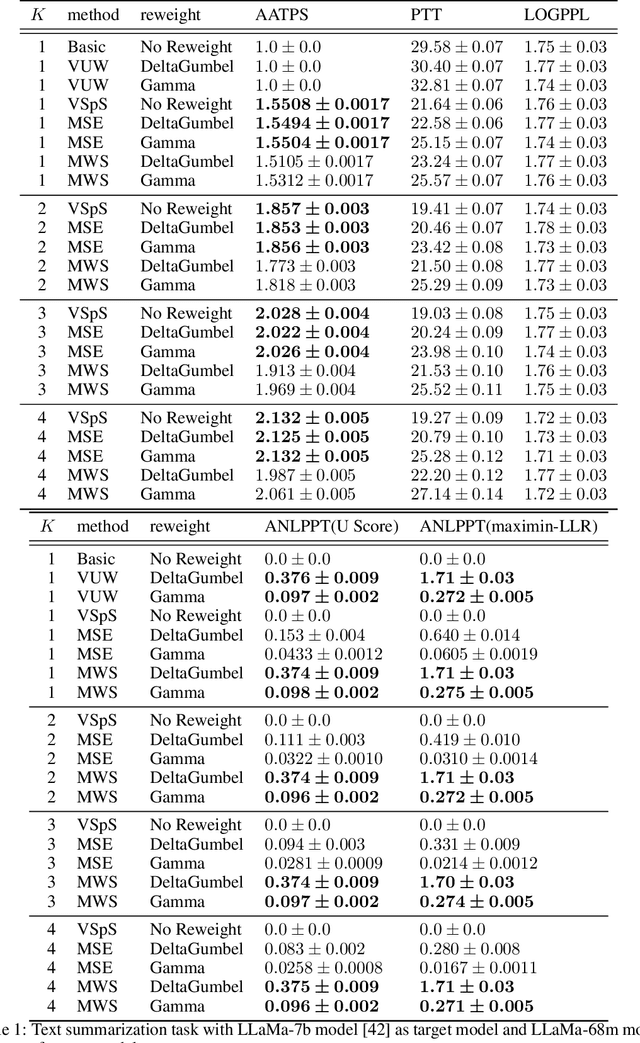
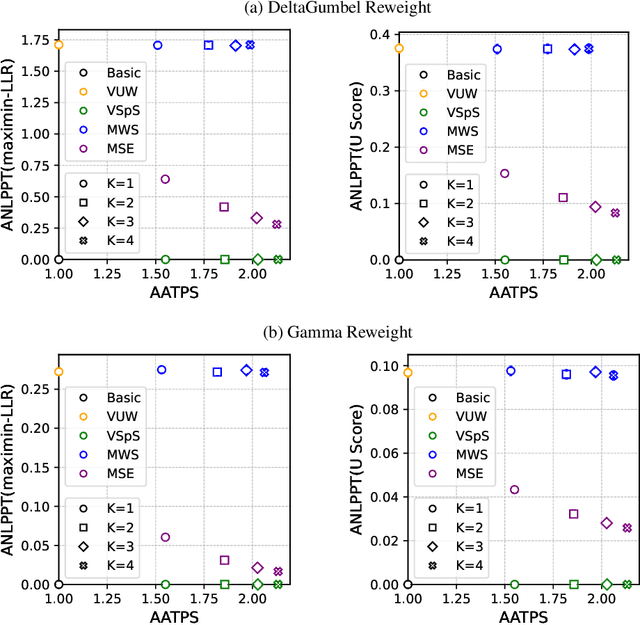
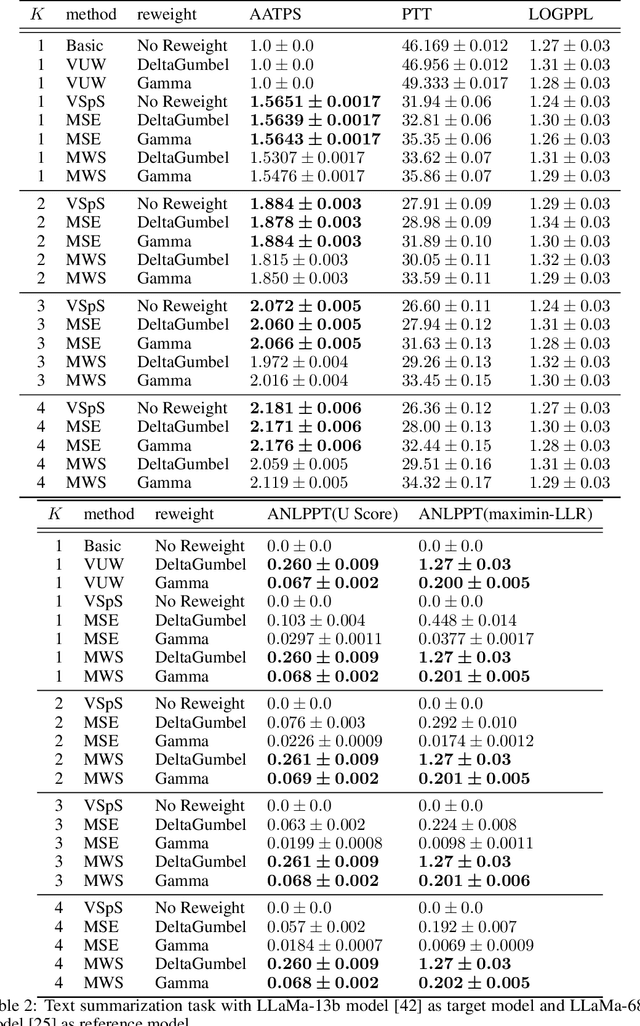
Abstract:Large language models are probabilistic models, and the process of generating content is essentially sampling from the output distribution of the language model. Existing watermarking techniques inject watermarks into the generated content without altering the output quality. On the other hand, existing acceleration techniques, specifically speculative sampling, leverage a draft model to speed up the sampling process while preserving the output distribution. However, there is no known method to simultaneously accelerate the sampling process and inject watermarks into the generated content. In this paper, we investigate this direction and find that the integration of watermarking and acceleration is non-trivial. We prove a no-go theorem, which states that it is impossible to simultaneously maintain the highest watermark strength and the highest sampling efficiency. Furthermore, we propose two methods that maintain either the sampling efficiency or the watermark strength, but not both. Our work provides a rigorous theoretical foundation for understanding the inherent trade-off between watermark strength and sampling efficiency in accelerating the generation of watermarked tokens for large language models. We also conduct numerical experiments to validate our theoretical findings and demonstrate the effectiveness of the proposed methods.
 Add to Chrome
Add to Chrome Add to Firefox
Add to Firefox Add to Edge
Add to Edge